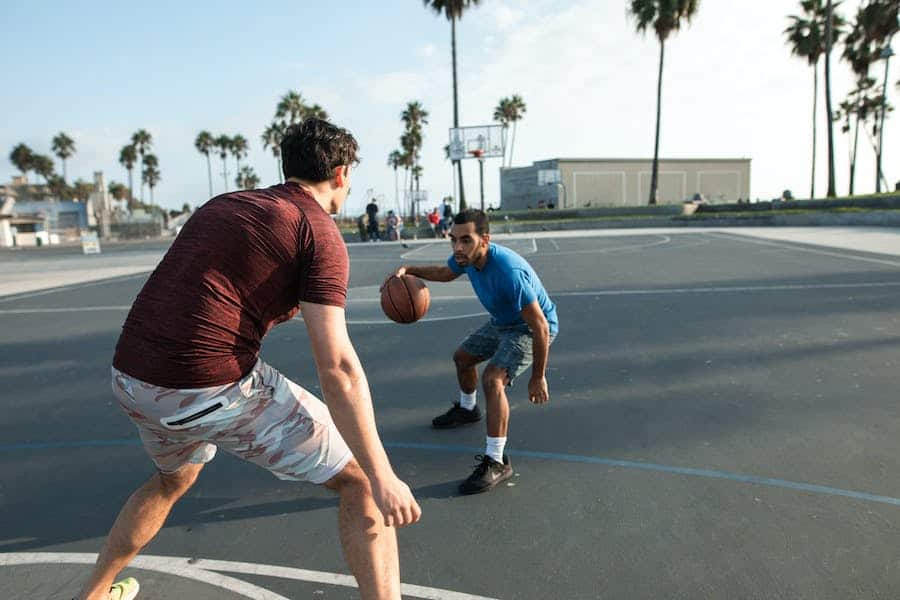Basketball, a game of agility, strategy, and skill, often evokes images of soaring slam dunks, nimble footwork, and long-range three-pointers. Within this intricate dance on the hardwood lies a tapestry of player positions, each with its distinct responsibilities and importance. And while many casual fans might be enamored with the flashiness of guards or the towering dominance of centers, there exists a position that often serves as the backbone of many teams – the power forward. Nestled between the finesse of the small forward and the sheer size of the center, the power forward combines the best of both worlds, often displaying both strength and skill. Historically, they’ve anchored teams from the low post, demonstrated prowess in rebounding, and showcased an ability to score both inside and out. But as the game has evolved, so too has the role of the power forward, blending traditional responsibilities with the demands of modern basketball. This post delves deep into the world of power forwards, tracing their evolution, highlighting their importance, and celebrating their undeniable impact on the game of basketball. Join us as we unpack the intricacies of this versatile position.
What Is A Power Forward In Basketball?
A power forward (often abbreviated as PF) in basketball is one of the five primary playing positions. Typically taller than guards but more agile than centers, power forwards play close to the basket, combining strength and skill. Their responsibilities usually include scoring from the post, grabbing rebounds, playing defense against big opponents, and occasionally shooting from mid-range or even beyond the three-point line. The evolution of basketball has seen the role of the power forward expand, with many modern power forwards, known as “stretch fours,” displaying proficiency in long-range shooting. In essence, the power forward is a versatile position, blending the physicality of inside play with the finesse of perimeter skills.
Physical Characteristics Of A Power Forward
Basketball is a sport where each position has its own unique set of demands, and the power forward (PF) position is no exception. Traditionally regarded as one of the “bigs” on the court, the power forward is expected to engage in tussles under the rim, set solid screens, and often be a team’s enforcer. With this comes the necessity for a certain physical stature and set of attributes.
- Height: Typically, a power forward’s height ranges from 6’7” to 6’11”, though there are exceptions on both ends of this scale. This height advantage is essential for the PF role, allowing them to compete effectively against other big players in both offensive and defensive situations, especially when rebounding or contesting shots.
- Build: The power forward position demands a combination of muscle mass and agility. As a result, most PFs have a robust and athletic build. This doesn’t mean they’re bulky like traditional centers. Instead, they have enough muscle definition to withstand the physicality inside the paint while maintaining the agility to drive to the basket or defend in open space.
- Wingspan: A longer wingspan is a distinct advantage for power forwards. It not only aids in rebounding and shot-blocking but also in creating shooting opportunities over defenders. A wider wingspan also helps in defending, allowing the PF to contest shots more effectively and reach for steals.
- Footwork: While not strictly a static physical characteristic, the footwork of a power forward is a crucial aspect of their game. Having large but nimble feet allows them to pivot, spin, and change direction with ease. This agility is vital for post moves, defensive positioning, and transitioning up and down the court.
- Endurance And Strength: Playing near the basket requires endurance and physical strength. Power forwards frequently wrestle for position in the post, battle for rebounds, and absorb contact when driving to the hoop. Their physical conditioning often emphasizes core strength, lower body power, and upper body resilience, allowing them to perform their duties without being easily overpowered.
- Evolution Of The Power Forward’s Physique: It’s essential to note that the physical characteristics of power forwards have evolved over the years. With the game of basketball becoming faster and more perimeter-oriented, the modern power forward often looks different from their counterparts from a few decades ago. The emphasis on three-point shooting and spacing the floor means that many of today’s PFs are leaner and more agile, often resembling oversized small forwards. This shift has been dubbed the emergence of the “stretch four” – a power forward capable of stretching the defense by reliably shooting from long-range.
How Do I Become A Good Power Forward?
Becoming a proficient power forward in basketball is not just about height or natural athleticism; it’s about honing specific skills and adapting to the evolving demands of the position. Here are five ways you can develop into a top-tier power forward:
Master The Fundamentals:
Start with the basics. Perfect your shooting form, work on your ball-handling, and ensure that your passing is accurate. Especially crucial for power forwards is footwork in the post. This doesn’t mean just back-to-the-basket moves; you should also be comfortable facing up against your defender. A power forward with strong fundamentals becomes an asset to any team and can adapt to various in-game situations.
Prioritize Physical Fitness:
Strength and conditioning are paramount for a power forward. This position often requires battling in the post, setting robust screens, and running the floor in transition. Regular weight training will help you hold your own against other bigs, while cardiovascular exercises ensure that you maintain your stamina throughout the game. Flexibility exercises, like yoga or dynamic stretching, can also enhance your agility and reduce the risk of injuries.
Develop A Reliable Jump Shot:
Modern basketball increasingly values big men who can shoot. By adding a consistent mid-range or even three-point shot to your repertoire, you increase your offensive versatility, forcing defenders to guard you further from the basket. This spacing can be valuable to your team’s offense and can create driving lanes for your teammates.
Understand Defensive Principles:
Defense is as much about intellect as it is about physical ability. Learn to anticipate your opponent’s moves, study their tendencies, and recognize common offensive sets. As a power forward, you’ll often be involved in pick-and-roll situations, so understanding how to defend these effectively, whether through hedging, switching, or going under screens, is essential. Moreover, developed a knack for rebounding by reading the ball’s trajectory off the rim and establishing good positioning.
Continuously Study The Game:
The best players are often those who combine their physical skills with a deep understanding of basketball. Regularly watch games, both of your own performances and of professional power forwards. Analyze their moves, decision-making, and how they respond to different defensive strategies. By learning from the best and continually refining your own game, you can mold yourself into a formidable power forward, ready for any challenge on the court.
What Is The Difference Between A Power Forward And A Center?
The distinction between a power forward and a center in basketball can sometimes seem subtle, given that both positions are typically played by the taller members of the team and are often situated near the basket. However, there are discernible differences in their roles, skills, and attributes.
- Positioning And Role On The Court: Centers are traditionally the tallest players on the team and are positioned closest to the basket. They act as the primary rim protectors on defense and are often the focal point in post-offense. Their role often revolves around scoring in close proximity to the basket, blocking shots, and grabbing rebounds. Conversely, power forwards, while also positioned near the basket, tend to operate from the high or low post and may frequently move to the perimeter, especially in modern basketball.
- Skill Set: Centers, due to their proximity to the basket, often specialize in back-to-the-basket post moves, put-backs, and hook shots. Their game relies heavily on their size and strength. Power forwards, while also proficient in post-play, tend to have a broader skill set that includes mid-range jump shots, face-up drives, and, increasingly in the modern game, three-point shooting capabilities.
- Physical Attributes: Though both positions require height and strength, centers are usually the most towering players on the court. They possess a dominant presence in the paint, both offensively and defensively. Power forwards, on the other hand, might be slightly shorter and are often more agile, allowing them to defend multiple positions and adapt to the faster pace of perimeter play.
- Evolving Roles In Modern Basketball: The distinction between power forwards and centers has become somewhat blurred in recent years. The modern game, with its emphasis on pace and space, often features “small-ball” lineups where traditional power forwards take up the center position. Conversely, many centers have expanded their skill sets to incorporate aspects typical of power forwards, like shooting from a distance or handling the ball.
Conclusion
In the diverse tapestry of basketball positions, the power forward stands out as a unique blend of strength, skill, and versatility. Historically anchored close to the basket, the power forward has evolved with the changing landscape of the sport, adapting to both traditional post-play and the demands of modern perimeter basketball. Their ability to transition between the paint and the three-point line, to rebound with tenacity, and to defend various positions speaks volumes about their importance on the court. While the role of the power forward has seen shifts and adaptations over the years, its essence remains rooted in a balance of physicality and finesse. As basketball continues its global expansion and tactical evolution, the power forward will undoubtedly remain in a pivotal position, emblematic of the sport’s rich history and its promising future.
FAQ’s
Q: How Many Points Should A Power Forward Average?
A: The number of points a power forward should average can vary based on the team’s offensive system, the player’s specific role, and the league’s overall playing style. In the NBA, a starting power forward on a prominent team might average anywhere from 10 to 25 points or more per game. Role players or power forwards in more defensively-oriented systems might have lower averages. It’s essential to evaluate a power forward’s contribution beyond just points, as they often play crucial roles in rebounding, defense, and facilitating plays.
Q: Do Power Forwards Shoot Mid-Range?
A: Yes, many power forwards have mid-range shooting as a part of their offensive arsenal. While the modern game emphasizes three-point shooting and efficiency near the basket, mid-range shots can be a valuable tool, especially in specific game situations or when exploiting defensive mismatches. Many elite power forwards have developed reliable mid-range shots to diversify their offensive game.
Q: Who Is A Good Power Forward In The NBA?
A: As of my last training cut-off in 2022, some of the top power forwards in the NBA included players like Giannis Antetokounmpo of the Milwaukee Bucks, Anthony Davis of the Los Angeles Lakers, and Jayson Tatum of the Boston Celtics. The NBA is rich in talent, and the power forward position has many standout players who excel in different aspects of the game. It’s worth noting that the landscape of the NBA evolves rapidly, with emerging stars and evolving player roles, so the list of top power forwards might see new additions or shifts over time.
















Leave a Reply